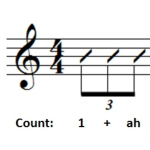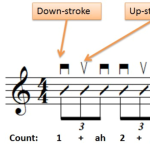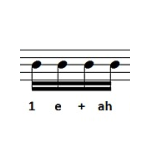Introduction
Now it’s time to jump into some chord progressions that use triplets.
We will use a popular chord progression that you have probably heard in many early rock songs.
The chord progression is known as a I-VI-IV-V chord progression.
We often use Roman Numerals for chord progressions. This makes it much easier to understand, transpose and memorize the chord progressions used in songs.
We won’t be focusing on the details of Roman Numerals in this tutorial, but here is what you do need to know right now.
The I-VI-IV-V Chord Progression
A I-VI-IV-V chord progression is simply a progression consisting of chords built off of the first (I), sixth (VI), fourth (IV), and fifth (V) notes of the major scale.
In the C major scale the notes are:
C-D-E-F-G-A-B-C
If we build chords on the I, VI, IV and V notes of the C major scale, we get:
C major, A minor, F major and G major.
A I-VI-IV-V chord progression in G major consists of:
G major, E minor, C major, and D major.
In later tutorials we will look at why some of these chords are major while others are minor.
Here are the fingerings for G, E min, C and D.
Here is the first strumming pattern:
Practice this chord progression with the three different triplet picking patterns we looked at in our previous tutorial Playing Rhythm Guitar: Understanding Triplets Part 2.
Once you’ve got the above chord progression with straight triplets down, work on the following rhythm pattern.
Recommended Resource
Isn’t it time to get your hands on a proven, fast and easy way to learn the basics of music theory for guitar? The Absolute Essentials of Music Theory for Guitar lays out what you need to know about guitar music theory so it’s crystal-clear.
Mastering the basics of guitar theory will open up a whole new world for you. You will learn guitar faster and feel and hear big improvements in your guitar playing.
Get started now and take the mystery out of music theory so you can learn guitar faster…










